Why this resume works
- Highlights industry-specific skills: By showcasing roles like marine engine specialist, the applicant reveals specialized expertise tailored to the marine services industry.
- Quantifies accomplishments: Measurable accomplishments, such as reducing maintenance costs by 20% and increasing customer satisfaction by 30%, emphasize tangible impact and value.
- Showcases career progression: The transition from marine equipment technician to boat mechanic highlights an upward trajectory in responsibility and skill development.
More Boat Mechanic Resume Examples
Explore our boat mechanic resume examples to learn how to showcase your repair skills, technical expertise, and hands-on experience. These mechanics resume samples can help you create a standout resume for marine maintenance roles.
Entry-Level Boat Mechanic
Why this resume works
- Effective use of keywords: Integrating role-specific keywords like marine engine diagnostics and electrical system repair ensures compatibility with ATS.
- Shows digital literacy: Focusing on advanced tools and systems in marine engineering reflects a solid grasp of modern computer skills essential for today’s technical roles.
- Puts skills at the forefront: Placing technical abilities like vessel safety assurance prominently aligns well with a skills-based resume format, emphasizing expertise for early-career applicants.
Mid-Level Boat Mechanic
Why this resume works
- Points to measurable outcomes: By reducing downtime by 30% and increasing engine lifespan by 35%, the applicant illustrates a strong impact on operational efficiency and equipment longevity.
- Displays technical expertise: Certifications in advanced engine diagnostics and marine technician roles highlight the applicant’s depth of knowledge, ensuring top-notch repair and maintenance capabilities.
- Demonstrates language abilities: The applicant’s language skills in Spanish, French, and Italian facilitate diverse client interactions and foster an inclusive work environment.
Experienced Boat Mechanic
Why this resume works
- Showcases impressive accomplishments: By highlighting achievements like improving engine efficiency by 30%, the applicant effectively showcases impressive accomplishments with significant business impact.
- Focuses on work history: The applicant’s use of a chronological resume format effectively details extensive work history in their field.
- Emphasizes leadership skills: Training junior staff and improving team productivity exemplifies the applicant’s leadership skills within marine technical roles.
Boat Mechanic Resume Template (Text Version)
Daniel Nguyen
Columbus, OH 43205
(555)555-5555
Daniel.Nguyen@example.com
Professional Summary
Experienced boat mechanic skilled in engine diagnostics and repair. Proven track record in customer satisfaction and cost reduction. Strong team leader with expertise in safety compliance and preventive maintenance.
Work History
Boat Mechanic
OceanWorks Marine Services – Columbus, OH
March 2022 – August 2025
- Repaired 50+ vessels annually, ensuring safety standards
- Increased customer satisfaction by 30% through quality service
- Reduced maintenance costs by 20% via efficient parts sourcing
Marine Engine Specialist
HarborTech Mechanics – Cincinnati, OH
March 2017 – February 2022
- Diagnosed 200+ engine issues with 95% accuracy rate
- Streamlined inventory system, cutting costs by 15%
- Led team to improve turnaround time by 25%
Marine Equipment Technician
WaveRider Boatworks – Cincinnati, OH
February 2016 – February 2017
- Serviced 120+ boats, optimizing performance metrics
- Implemented new tool management, saving 10% in expenses
- Improved diagnostic procedures, boosting speed by 20%
Skills
- Marine Engine Diagnostics
- Boat Repair and Maintenance
- Engine Overhauls
- Electrical Systems Troubleshooting
- Preventative Maintenance Planning
- Customer Service Excellence
- Safety Compliance
- Inventory Management
Education
Master’s Marine Engineering
University of Miami Miami, Florida
May 2015
Bachelor’s Mechanical Engineering
Florida State University Tallahassee, Florida
May 2013
Certifications
- Certified Marine Technician – American Boat and Yacht Council
- Marine Electrical Fundamentals – National Marine Electronics Association
Languages
- Spanish – Beginner (A1)
- Portuguese – Beginner (A1)
- French – Beginner (A1)
Related Resume Guides
Advice for Writing Your Boat Mechanic Resume
Dive into our advice section on how to write a resume for a boat mechanic position. Discover tailored tips that will help you highlight your technical skills, experience with marine engines, and passion for keeping boats running smoothly.
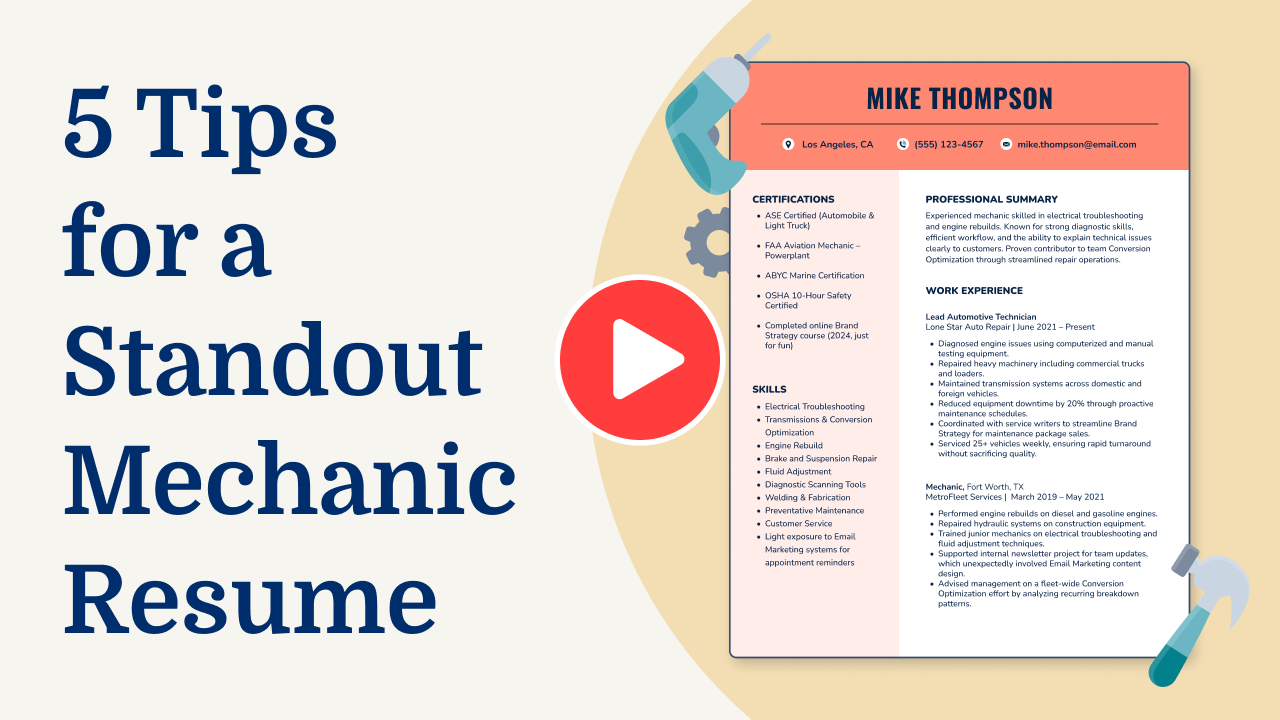
Highlight relevant technical skills
For a boat mechanic, technical skills are the backbone of the job. It’s important to either create a dedicated skills section or weave these skills into your work experience descriptions. This approach helps employers quickly see that you have what it takes to fix and maintain boats. Make sure your skills list is clear and easy to read so hiring managers can easily spot what they’re looking for.
Some key technical skills for a boat mechanic include engine repair, hydraulic systems, electrical system troubleshooting, and familiarity with propulsion systems. Having expertise in using diagnostic equipment is also important. Additionally, mentioning any experience with fiberglass repair and welding can be beneficial since these tasks are often part of the job.
When listing your skills, always try to connect them to real-world experiences in previous jobs. For example, describe how you used engine repair skills to solve specific problems on past projects. This not only demonstrates your know-how but also shows potential employers that you can effectively apply these skills in their environment.
Example of a technical skills section
- Marine engine diagnostics and repair
- Outboard and inboard motor maintenance
- Electrical systems troubleshooting
- Fiberglass repair and gelcoat application
- Hydraulic systems servicing
- Fuel system cleaning and tuning
- Propulsion system alignment and adjustment
- Boat trailer inspection and repair
- Use of diagnostic tools (OBD scanners, multimeters)
- Maritime safety regulations compliance
You can use our Resume Builder to craft a resume that highlights technical skills in addition to key soft skills like teamwork, communication, and adaptability.
Quantify your accomplishments
Quantifying accomplishments on your resume makes it much stronger than just listing what you did. When you show numbers, like how much time or money you saved, it lets hiring managers see exactly what you achieved. For example, instead of saying “repaired boats,” you could say “completed 50 boat repairs per month, reducing customer wait times by 20%.”
In the work experience section, be sure to list your job title, employer name, location, and employment dates. Then turn your duties into achievements using measurable results. For example, if you improved efficiency or cut costs, include those details: “Implemented a new system for parts inventory that reduced costs by 15%.” Using action verbs and metrics makes your resume focused on results.
Quantified accomplishments let hiring managers quickly see your impact and skills. They can easily understand how well you performed in previous roles. By showing specific examples of how you improved processes or saved resources, you’re proving that you’re valuable and capable of delivering results as a boat mechanic.
5 boat mechanic work history bullet points
- Diagnosed and repaired complex engine issues, improving boat operational efficiency by 25%.
- Conducted routine maintenance on over 50 vessels annually, ensuring compliance with safety regulations.
- Implemented a new inventory management system, reducing parts retrieval time by 40% and improving workflow.
- Collaborated with a team of mechanics to refurbish aged boats, increasing resale value by 15%.
- Trained junior technicians in advanced diagnostic techniques, boosting team productivity by 30%.
Want to make your resume shine? Use our professional resume examples to find great ideas and make your resume stand out.
Write a powerful professional summary
A professional summary on a resume serves as an introduction for hiring managers, providing a snapshot of your skills and accomplishments. You can decide whether to use a summary or a resume objective based on your experience level and career goals.
The professional summary is a brief section that highlights your experience, skills, and achievements in three to four sentences. It’s ideal for experienced applicants aiming to display their professional identity and value quickly.
Resume objectives are statements focusing on your career goals and are best suited for entry-level job seekers, those changing careers, or individuals with employment gaps. Unlike summaries that highlight past accomplishments, objectives emphasize what you aim to contribute to the role.
Next, we’ll provide examples of both summaries and objectives tailored for various industries and experience levels, assisting you in deciding which fits best for your boat mechanic position.
Boat mechanic resume summary examples
Entry-level
Recent graduate with a diploma in marine mechanics, specializing in outboard and inboard engine repair. Completed an internship at a local marina, gaining hands-on experience in basic troubleshooting and maintenance tasks. Certified by the American Boat & Yacht Council (ABYC) and eager to apply foundational skills to support seasoned boat mechanics.
Mid-career
Skilled boat mechanic with over six years of experience in servicing various types of watercraft engines, including diesel and gasoline systems. Proven track record in diagnosing complex mechanical issues and implementing effective solutions. ABYC-certified technician known for detailed inspections, customer service excellence, and improving operational efficiency on-site.
Experienced
Veteran boat mechanic with deep expertise in advanced propulsion systems and electrical diagnostics. Over 15 years of industry experience leading teams on large-scale repairs for commercial vessels. Holder of multiple certifications, including marine electronics installation, recognized for driving safety improvements and optimizing performance standards across diverse maritime projects.
Boat mechanic resume objective examples
Recent graduate
Detail-oriented recent graduate with a diploma in marine mechanics eager to start a career as a boat mechanic. Looking to apply hands-on training and knowledge of engine repair and maintenance in a fast-paced marina environment. Committed to ensuring the safety and reliability of all vessel operations.
Career changer
Dedicated automotive technician transitioning into the marine industry, seeking an entry-level boat mechanic position. Equipped with transferable skills in engine diagnostics and repair, excited to bring technical expertise and problem-solving abilities to support smooth boating experiences for clients.
Specialized training
Marine technology program graduate with specialized training in outboard motors, looking for an opportunity to grow as a boat mechanic. Eager to contribute technical skills and a strong work ethic at a reputable boatyard, while continuing to learn and tackle diverse mechanical challenges on various types of watercraft.
Pick a simple resume template with clear sections and easy-to-read fonts. Avoid flashy designs or colors so employers can quickly focus on your experience, skills, and job roles.
Showcase your credentials
Listing certifications, licenses, and specialized training on your resume is important for a boat mechanic. These credentials show that you have the skills and knowledge needed to do the job well. They also help employers see that you are committed to staying updated in your field. By including these details, you can stand out from other applicants. Here are a few examples:
- American Boat & Yacht Council (ABYC) Certification
- Marine Mechanic Institute (MMI) Training
- National Marine Electronics Association (NMEA) Certification
- Yamaha Outboard Technician Certification
- Mercury Marine Certification
Creating a dedicated certifications section on your resume makes it easy for employers to see your qualifications. This section can be added alongside your education section to give a complete picture of your expertise. Having industry-recognized certifications can greatly increase your chances of success as a boat mechanic.
Example of a certifications section
ABYC Marine Electrical Certification
Issued by: American Boat and Yacht Council (ABYC)
Issued 2022
Certified Marine Technician
Issued by: National Marine Manufacturers Association (NMMA)
Expires 2024
Mercury Marine Technical Certification
Issued by: Mercury Marine
Issued 2021
Yamaha Outboard Motor Certification
Issued by: Yamaha Motor Corporation, USA
Expires 2025
NMEA Advanced Marine Electronics Installer
Issued by: National Marine Electronics Association (NMEA)
[Enter Expiration Date]
Use a polished and professional resume format that aligns with your experience level to ensure your skills and qualifications stand out to hiring managers.
Salary Insights for Boat Mechanics
Understanding salary data can help you make informed decisions about your career path and negotiation strategy. Explore key insights below to guide your research.
Top 10 highest-paying states for boat mechanics
Boat Mechanics earn varying salaries across the United States, with a national average of $54,398. The table below highlights the states where boat mechanics command the highest compensation.
Our salary information comes from the U.S. Bureau of Labor Statistics’ Occupational Employment and Wage Statistics survey. This official government data provides the most comprehensive and reliable salary information for boat mechanics across all 50 states and the District of Columbia. The figures presented here reflect the May 2025 dataset, which is the most recent available as of this publication.
| State | Average Salary |
|---|---|
| Hawaii | $77,570 |
| Alaska | $72,830 |
| Washington | $70,790 |
| Virginia | $66,240 |
| Connecticut | $65,550 |
| Massachusetts | $65,970 |
| California | $64,840 |
| Nevada | $63,450 |
| Oregon | $62,330 |
| New Jersey | $61,090 |
FAQ
Do I need to include a cover letter with my boat mechanic resume?
Including a cover letter with your boat mechanic resume can give you an edge over other job seekers. A cover letter allows you to highlight your specific skills in marine engine repair and maintenance while explaining why you’re passionate about working on boats.
You could mention particular types of vessels you’ve worked on or any specialized training that makes you a strong fit for the role.
Using our Cover Letter Generator can help you craft a professional letter that complements your resume, ensuring all key points are covered effectively.
Additionally, checking out some cover letter examples can inspire and show how to structure your own letter for maximum impact.
How long should a boat mechanic’s resume be?
For a boat mechanic, a concise one-page resume is typically ideal for showcasing key skills such as engine diagnostics, repair techniques, and familiarity with different marine systems. This format effectively highlights your practical experience and specialized training.
However, if you have extensive experience or multiple certifications specific to boat mechanics, opting for a two-page resume can be appropriate. It allows you to delve deeper into your achievements and significant projects without sacrificing clarity.
Explore our guide on how long a resume should be to find examples and tips on determining the best length for your career stage.
How do you write a boat mechanic resume with no experience?
Creating a resume with no experience as a boat mechanic can seem challenging, but focusing on your skills and enthusiasm for the role is key. Use this approach to craft a resume that grabs attention:
- Focus on relevant education: Start by listing any specialized courses or certifications related to marine mechanics or automotive repair, as these show foundational knowledge.
- Include hands-on training: Highlight any workshops, apprenticeships, or volunteer work you’ve done where you gained practical mechanical skills. Even if not directly related to boats, experiences like fixing cars or working in a workshop can be relevant.
- Emphasize transferable skills: Mention soft skills such as problem-solving, attention to detail, and teamwork. These are important in a mechanic’s role and can be developed through various experiences, like part-time jobs or school projects.
See our guide on writing a resume with no experience for more detailed advice on crafting a resume specifically tailored to entry-level boat mechanic positions.
Rate this article
Boat Mechanic
Additional Resources
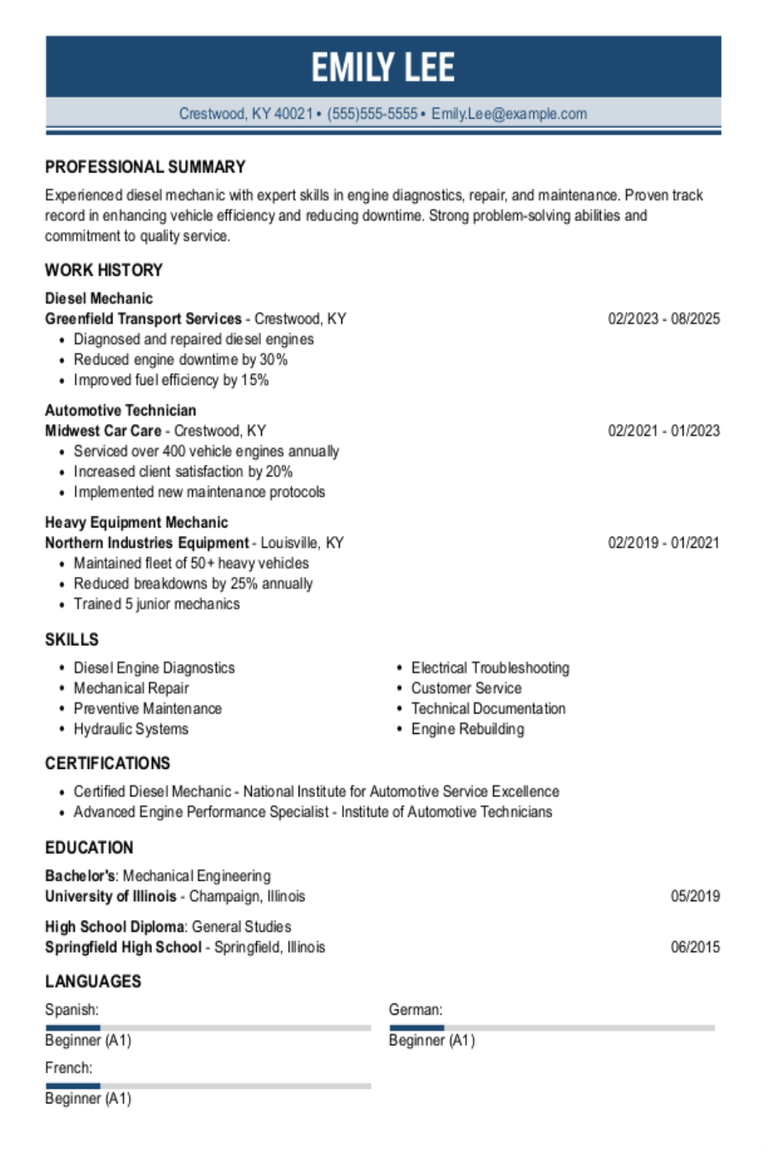
Diesel Mechanic Resume Examples & Templates for 2025
Explore diesel mechanic resume examples to see how to list repair skills and experience working with heavy equipment. Use these samples and tips to share hands-on experience that stands out
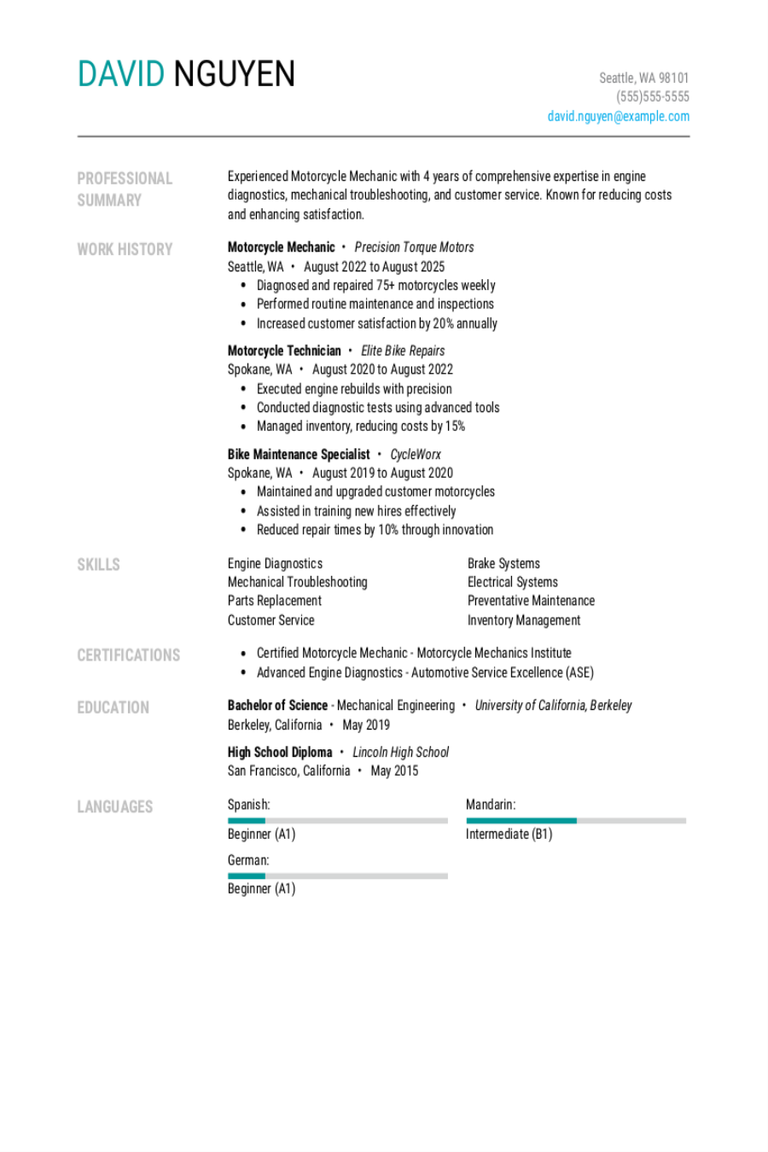
Motorcycle Mechanic Resume Examples & Templates for 2025
Discover how motorcycle mechanics can showcase their skills in fixing engines and maintaining bikes. These examples and tips will help you spotlight your hands-on experience and love for motorcycles to
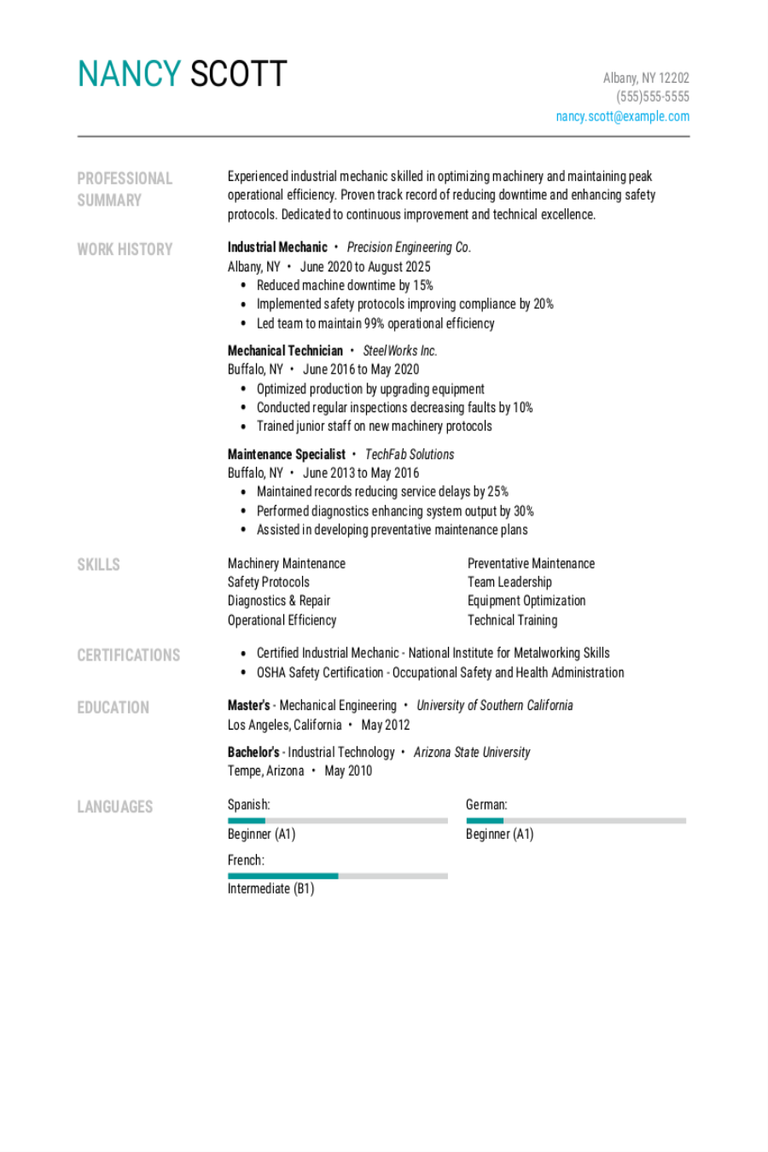
Industrial Mechanic Resume Examples & Templates for 2025
Explore how industrial mechanics highlight fixing machines and keeping equipment running smoothly on their resume. These examples and tips show you how to make your skills and experience shine on
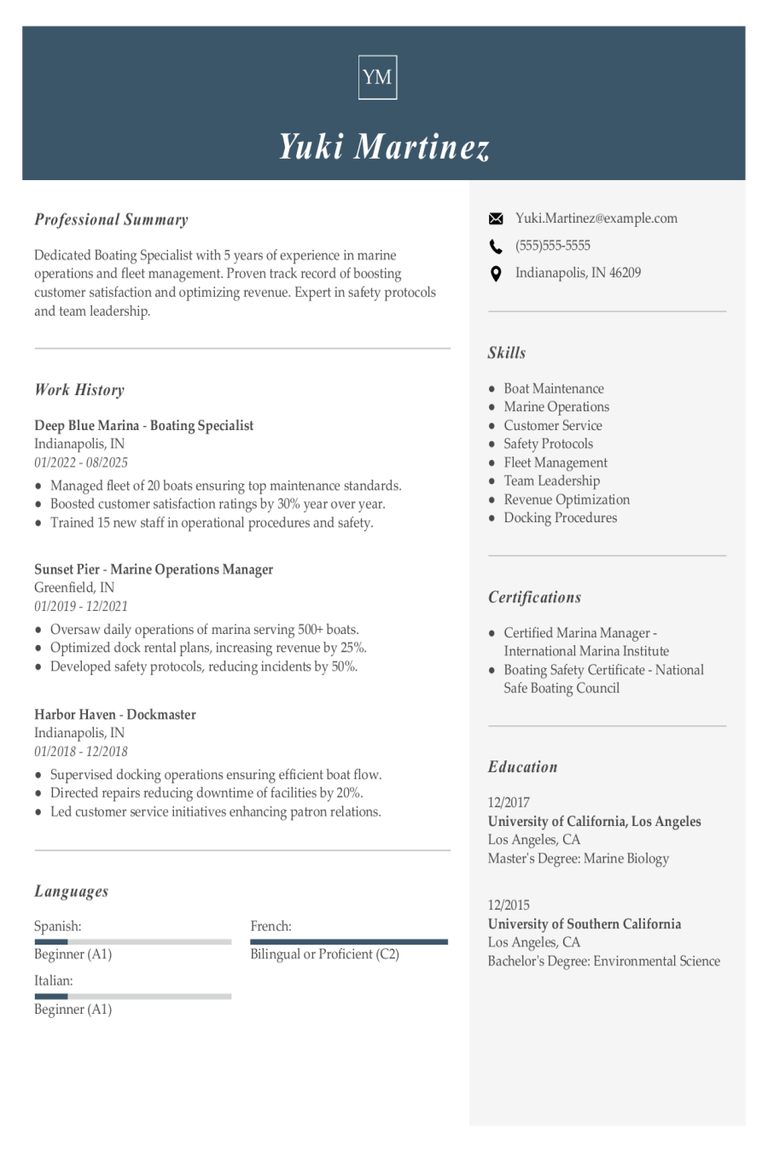
Boating Resume Examples & Templates for 2025
Explore boating resumes to see how to highlight your ability to navigate waters, maintain vessels, and ensure passenger safety. These examples and tips can help you showcase your skills in
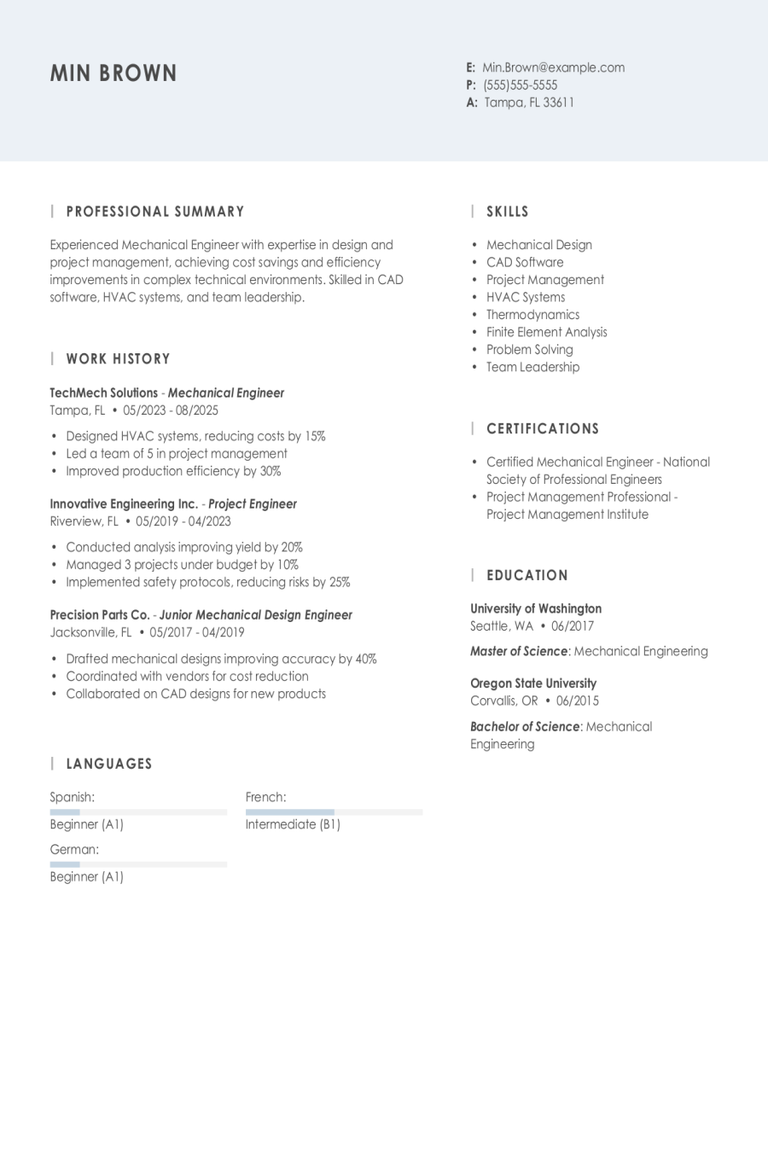
Mechanical Engineering Resume Examples & Templates for 2025
Explore mechanical engineering resume examples that show you how to highlight design skills, problem-solving abilities, and experience with machines. Learn to showcase your role in creating efficient systems and improving
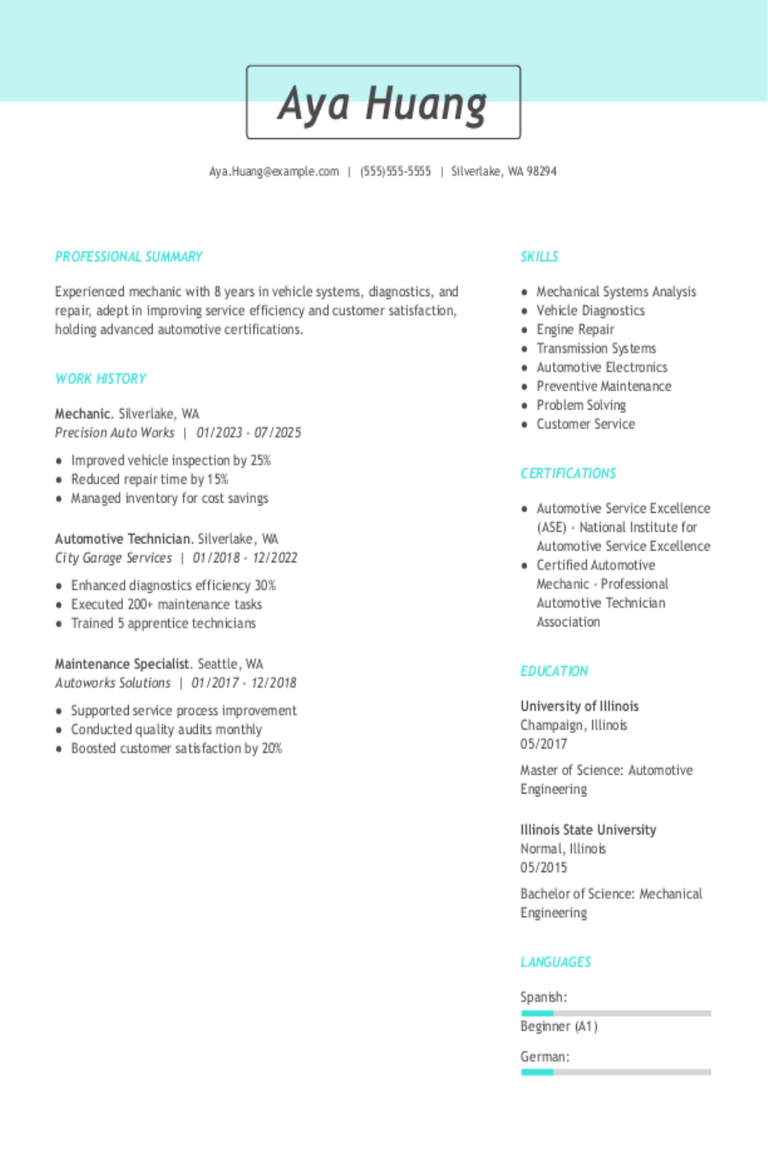
Mechanics Resume Examples & Templates for 2025
Discover mechanic resume examples to see how to showcase your hands-on skills and repair experience. Learn how to highlight your expertise in fixing vehicles and impress auto shops looking for
